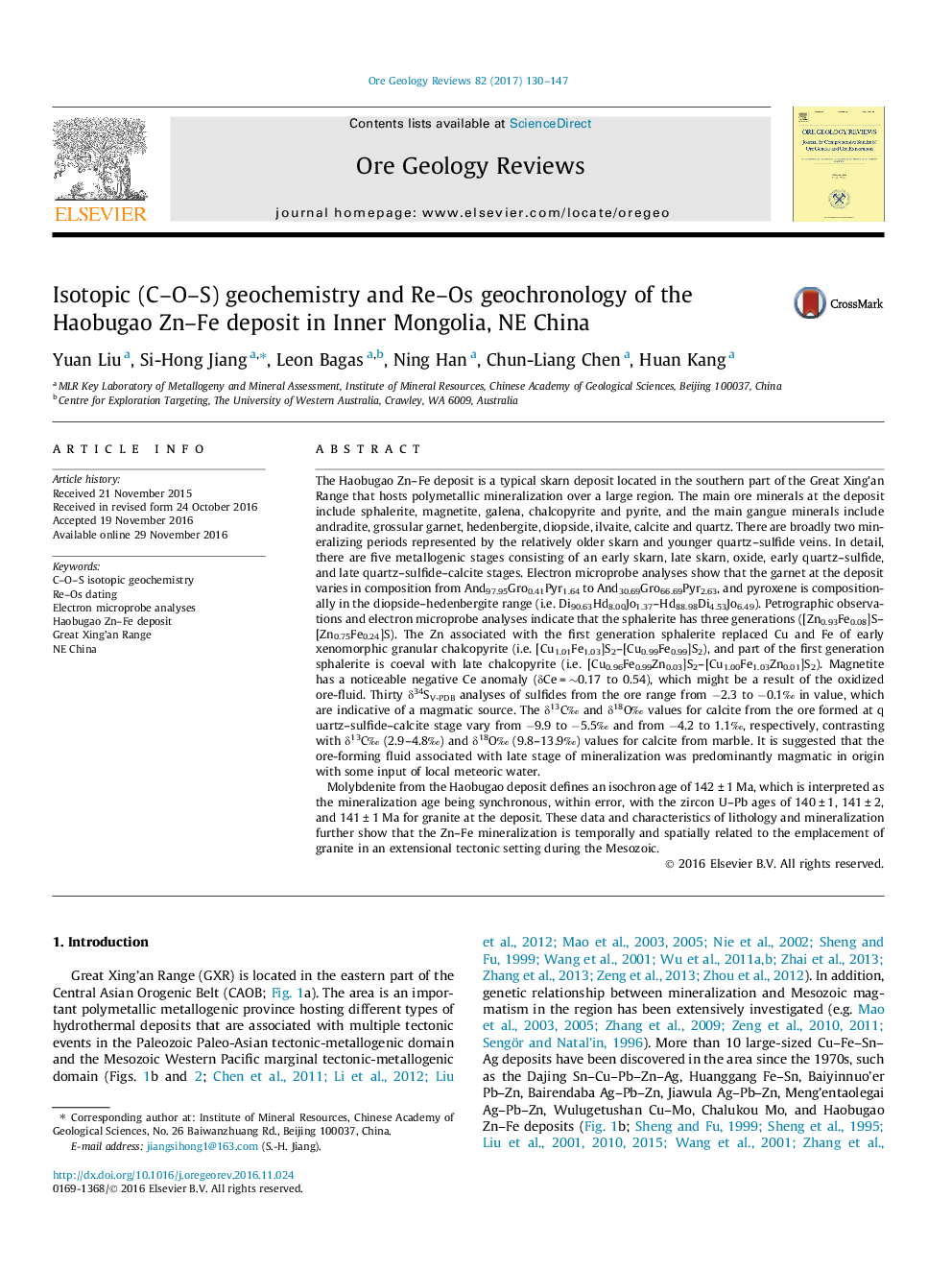| کد مقاله | کد نشریه | سال انتشار | مقاله انگلیسی | نسخه تمام متن |
|---|---|---|---|---|
| 5782373 | 1637225 | 2017 | 18 صفحه PDF | دانلود رایگان |

- Petrography and EMPA indicate that the sphalerite has three generations.
- The ore fluid was deep magmatic in origin mixing with minor meteoric water.
- The Zn-Fe mineralization is related to an extensional setting during the Mesozoic.
The Haobugao Zn-Fe deposit is a typical skarn deposit located in the southern part of the Great Xing'an Range that hosts polymetallic mineralization over a large region. The main ore minerals at the deposit include sphalerite, magnetite, galena, chalcopyrite and pyrite, and the main gangue minerals include andradite, grossular garnet, hedenbergite, diopside, ilvaite, calcite and quartz. There are broadly two mineralizing periods represented by the relatively older skarn and younger quartz-sulfide veins. In detail, there are five metallogenic stages consisting of an early skarn, late skarn, oxide, early quartz-sulfide, and late quartz-sulfide-calcite stages. Electron microprobe analyses show that the garnet at the deposit varies in composition from And97.95Gro0.41Pyr1.64 to And30.69Gro66.69Pyr2.63, and pyroxene is compositionally in the diopside-hedenbergite range (i.e. Di90.63Hd8.00Jo1.37-Hd88.98Di4.53Jo6.49). Petrographic observations and electron microprobe analyses indicate that the sphalerite has three generations ([Zn0.93Fe0.08]S-[Zn0.75Fe0.24]S). The Zn associated with the first generation sphalerite replaced Cu and Fe of early xenomorphic granular chalcopyrite (i.e. [Cu1.01Fe1.03]S2-[Cu0.99Fe0.99]S2), and part of the first generation sphalerite is coeval with late chalcopyrite (i.e. [Cu0.96Fe0.99Zn0.03]S2-[Cu1.00Fe1.03Zn0.01]S2). Magnetite has a noticeable negative Ce anomaly (δCe = â¼0.17 to 0.54), which might be a result of the oxidized ore-fluid. Thirty δ34SV-PDB analyses of sulfides from the ore range from â2.3 to â0.1â° in value, which are indicative of a magmatic source. The δ13Câ° and δ18Oâ° values for calcite from the ore formed at quartz-sulfide-calcite stage vary from â9.9 to â5.5â° and from â4.2 to 1.1â°, respectively, contrasting with δ13Câ° (2.9-4.8â°) and δ18Oâ° (9.8-13.9â°) values for calcite from marble. It is suggested that the ore-forming fluid associated with late stage of mineralization was predominantly magmatic in origin with some input of local meteoric water.Molybdenite from the Haobugao deposit defines an isochron age of 142 ± 1 Ma, which is interpreted as the mineralization age being synchronous, within error, with the zircon U-Pb ages of 140 ± 1, 141 ± 2, and 141 ± 1 Ma for granite at the deposit. These data and characteristics of lithology and mineralization further show that the Zn-Fe mineralization is temporally and spatially related to the emplacement of granite in an extensional tectonic setting during the Mesozoic.
119
Journal: Ore Geology Reviews - Volume 82, April 2017, Pages 130-147